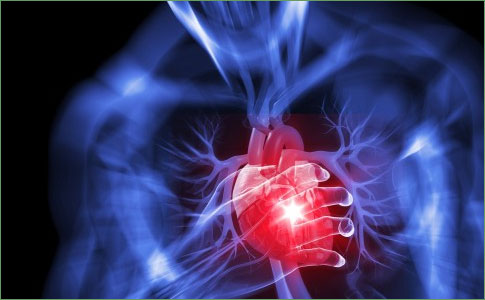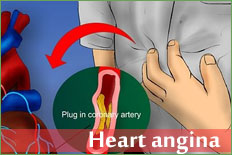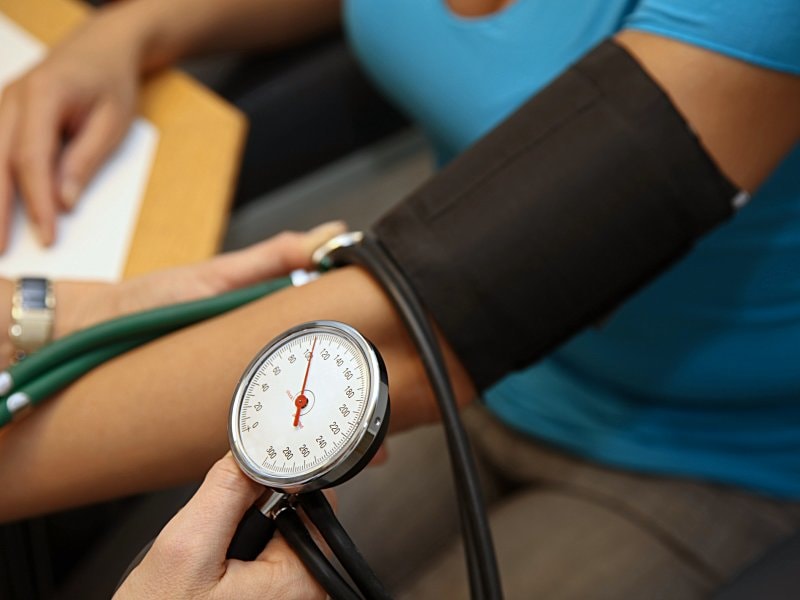Health Centers > Hypertension Health Center > Moderate or severe hypertension in children
Moderate or severe hypertension in children
Hypertension is defined as systolic or diastolic systemic arterial blood pressure above normal for age (Fig. 22-88). Moderate or severe arterial hypertension in children is uncommon and usually secondary to a detectable lesion. In adults, most arterial hypertension has no detectable cause and is termed essential or primary. Essential hypertension is common; there are about 60 million people with arterial pressures above 140/90 mm Hg in the United States. Milder forms of hypertension may be common at all ages.
Measurement of blood pressure
The first time a patient is seen, measure blood pressure in at least one arm. If it is high, then measure pressures in the other arm and at least one leg. At subsequent visits, measurement in one arm is adequate as long as all pulses feel equal and the patient is over 2 months old. When pressure is measured in the arm, the patient should be resting and relaxed, in a quiet room, and either sitting or supine. Place the arm at heart level and apply a cuff firmly to the upper arm so that the center of the rubber bag within the cuff is over the brachial artery. The rubber bag must be wide enough to cover two thirds of the length of the upper arm and long enough to cover at least three fourths of the arm circumference. One of the most common causes of apparent hypertension is erroneous measurement from using too small a blood pressure cuff. Feel the brachial or radial pulse and inflate the cuff until the pulse disappears, then deflate the cuff and note the pressure at which the pulse reappears. After about 15 seconds, reinflate the cuff to about 30 mm Hg above the palpatory systolic pressure, place the stethoscope on the brachial artery, and deflate the cuff by 2 to 3 mm Hg per second. The first Korotkoff sounds indicate the systolic pressure. The sounds become louder, then suddenly become muffled, and finally disappear. The point of muffling (fourth phase) may be a better estimate of diastolic pressure than is the point of disappearance (fifth phase), which occasionally gives a false low reading. Repeat the measurements twice; often the third pressure is the lowest because the patient is more relaxed. Record the pulse rate with each measurement because tachycardia may denote anxiety that increases blood pressure. Leg pressures are measured with the patient prone so that the stethoscope can be placed on the popliteal artery. The rubber bag should cover two thirds of the thigh length and at least three fourths of its circumference; thus, a larger cuff is needed for the leg than for the arm.
In infants, blood pressure may be difficult to obtain by this method but can be measured by ultrasound (Doppler) devices.
Standards
Normal values are 5 to 10 mm Hg higher for those above the 95th percentile for weight or height than for those in the 50th percentiles. Systolic pressures are slightly higher, and diastolic pressures slightly lower, with the patient supine rather than erect. Different sets of standards may therefore differ from each other by as much as 10 mm Hg, and minor departures from normal standards should not be overemphasized, particularly because blood pressures (especially diastolic) can vary markedly from week to week.
Effects of Hypertension
Long-standing hypertension causes congestive heart failure or degenerative vascular diseases of the brain, kidneys, or heart. In adults it is the most common cause of congestive heart failure and is the precursor of most cerebral vascular accidents. By causing renal arteriolar damage, it contributes to renal failure. It is also a major risk factor in coronary artery disease, especially in women.
There is no particular level of blood pressure at which complications occur; each increment of pressure above the normal pressures adds to the risk of developing cardiovascular disease. A raised systolic pressure is as harmful as a raised diastolic pressure; the complications of hypertension depend on the average blood pressure load throughout the day. All these cardiovascular complications are uncommon in children unless pressures are extremely high. Nevertheless, because mild hypertension can progress to severe hypertension and eventually lead to these complications, recording and assessing blood pressures are important parts of any pediatric examination.
If the cause cannot be removed, or while awaiting definitive treatment, it may be necessary to lower the blood pressure. The aims of treatment are to lower blood pressure and reverse organ damage without inducing significant side effects. If there is renal disease, then renal function can deteriorate as pressures are lowered » » »
EMERGENCY TREATMENT
Hypertensive emergencies are those with very high blood pressures or with any of the features discussed earlier. If the blood pressure needs to be lowered rapidly, then the agents listed in Table 22-30 should be considered. more » » »
Essential Hypertension » »
Typically, essential hypertension is recognized in the third decade of life and progresses slowly over many years. Studies emphasize not only the strong familial incidence of essential hypertension but also that young children of hypertensive parents tend to have pressures at the upper limits of normal. In some children these pressures remain at the upper limits of normal and rise with age, and it might be these who in the third decade have pressures recognized as being above an arbitrary level and thus are diagnosed as having essential hypertension.
Whether the cause of essential hypertension is genetic, environmental, or a mixture of both is unknown, and we do not know if this is a single disease or a syndrome common to many different diseases. Adults with essential hypertension have various combinations of high, normal, and low renin and aldosterone concentrations, so that they are different physiologically. more » » »
MODERATE AND SEVERE HYPERTENSION
Moderate and severe hypertension includes those with pressures above the 99th percentile. Severity is defined by the features listed in Table 22-29, and those with severe hypertension should be admitted to hospital. They may even need to have their blood pressures lowered before investigations to prevent serious complications (Table 22-30).
Bibliography
AVAR MY , HOGG, RJ , ARANT BS JR , Seikaly MG: Etiology of sustained hypertension in children in the southwestern United States. Pediatr Nephrol 8:186, 1994
BALFE JW , LEVIN L , TSURU N , et al: Hypertension in childhood. Adv Pediatr 36:201, 1989
BAO W , THREEFOOT SA , SRINIVASAN SR , BERENSON GS: Essential hypertension predicted by tracking of elevated blood pressure from childhood to adult hood: the Bogalusa Heart Study. Am J Hypertens 8:657, 1995
CAULFIELD M , LAVENDER P , FARRALL M , et al: Linkage of the angiotensinogen gene to essential hypertension. N Engl J Med 330:1629, 1994
DEAL JE , SNELL ME , BARRATT TM , DILLON MJ: Renovascular disease in childhood. J Pediatr 25:55, 1992
HEDIGER ML , SCHALL JI , KATZ SH , et al: Resting blood pressure and pulse rate distributions in black adolescents. The Philadelphia blood pressure project. Pediatrics 74:1016, 1984
HILTON PJ: Cellular sodium transport in essential hypertension. N Engl J Med 221, 1986
HORAN MJ , LENFANT C: Epidemiology of blood pressure and predictors of hypertension. Hypertension 15(Suppl I):1, 1990
INGELFINGER JR: Pediatric Hypertension. Philadelphia, WB Saunders, 1982
JORGENSEN RS , HOUSTON BK: Family history of hypertension, personality patterns, and cardiovascular reactivity to stress. Psychosom Med 48:102, 1986
KAAS IK: Blood pressure in offspring of hypertensive parents. Acta Paediatr Scand 73:842, 1984
KURTZ TW , AL-BANDER HA , MORRIS RC JR: "Salt-sensitive" essential hypertension in man. N Engl J Med 317:1043, 1987
LAUER RM , BURNS TL , CLARKE WR: Assessing children's blood pressure: considerations of age and body size. The Muscatine study. Pediatrics 75:1081, 1985
LAUER RM , CLARKE WR , BEAGLEHOLE R: Level, trend, and variability of blood pressure during childhood. The Muscatine study. Circulation 69:242, 1984
LIFTON, RP: Molecular genetics of human blood pressure variation. Science 272:676, 1996
LOGGIE JMH: Hypertension in children and adolescents. I. Causes and diagnostic studies. J Pediatr 74:331, 1966
MAHONEY LT , CLARK WR , BURNS TL , LAUER RM: Childhood predictors of high blood pressure. Am J Hypertens 8:6085, 1991
PICKERING TG , LARAGH JH: Renovascular hypertension. In: BRENNER BM , RECTOR FC , eds: The Kidney. Philadelphia, WB Saunders, 1991
Report of the Second Task Force on Blood Pressure Control in Children - 1987. Pediatrics 79:1, 1987
ROSNER B , COOK NR , EVANS DA , et al: Reproducibility and predictive values of routine blood pressure measurements in children. Am J Epidemiol 126:1115, 1987
SINAIKO AR: Hypertension in children. N Engl J Med 335:1968, 1996
SOKOLOW M , PERLOFF D , COWAN R: Contribution of ambulatory blood pressure to the assessment of patients with mild to moderate elevation of office blood pressure. Cardiovasc Rev Rep 1:295, 1980
STRAUER BE , BAYER F , BRECHT HM , MOTZ W: The influence of sympathetic nervous activity on regression of cardiac hypertrophy. J Hypertens 3(Suppl 4):39, 1985
Update on the 1987 Task Force on High Blood Pressure in Children and Adolescents: A Working Group Report from the National High Blood Pressure Education Program. Pediatrics 98:649, 1996
VOORS AW , WEBBE LS , BERENSON G: Relationship of blood pressure levels to height and weight in children. Cardiovasc Med 3:911, 1978
WEINBERGER MH , MILLER JZ , LUFT FC , et al: Definitions and characteristics of sodium sensitivity and blood pressure resistance. Hypertension 8(Suppl II):127, 1986
WILLIAMS RR , HUNG SC , HASSTEDT SJ , et al: Multigenic human hypertension: evidence for subtypes and hope for haplo-types. J Hypertens 8(Suppl 7):S39, 1990
ZACHARIAH PK , SHEPS SG , ILSTRUP DM , et al: Blood pressure load - a better determinant of hypertension. Mayo Clin Proc 63:1085, 1988
DE QUATTRO V: Treating hypertensive crises: which drugs for which patient? J Crit Illness 2:24, 1987
FREIS ED: Should mild hypertension be treated? N Engl J Med 307:306, 1982
GARCIA JY , VIDT DG: Current management of hypertensive emergencies. Drugs 34:263, 1987
MACMAHON SW , WILCKEN DE , MACDONALD GJ: The effect of weight reduction on left ventricular mass. A randomized controlled trial in young, overweight hypertensive patients. N Engl J Med 314:334, 1986
SINAIKO AR: Treatment of hypertension in children. Pediatr Nephrol 8:603, 1994
WOLLAM GL , HALL WD , PORTER VD , et al: Time course of regression of left ventricular hypertrophy in treated hypertensive patients. Am J Med 75(Suppl):100, 1983
WOOD AJJ: Pharmacologic differences between beta blockers. Am Heart J 108:1070, 1984
KAPLAN NM , DEVERAUX RB , MILLER HS JR: Task Force 4: systemic hypertension. J Am Coll Cardiol 24:885, 1994
MARON BJ , MITCHELL JH: Revised eligibility criteria for competitive athletes with cardiovascular abnormalities. J Am Coll Cardiol 24:848, 1994
NUDEL DB , GOOTMAN N , BRUNSON SC , et al: Exercise performance of hypertensive adolescents. Pediatrics 65:1073, 1980
STRONG WB: Hypertension and sports. Pediatrics 64:693, 1979


